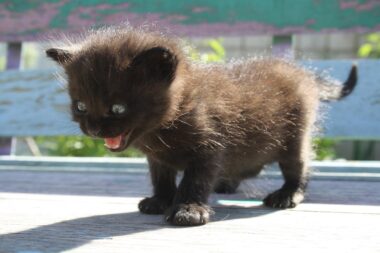Understanding Aggression in Cats: Causes and Solutions
Aggression in cats can manifest in various forms, often leading to difficulties for both the cat and its owner. Understanding the root causes of this behavior is crucial for addressing it effectively. Common causes of aggression might include fear, territorial disputes, and frustration. Fearful aggression usually stems from past trauma or unfamiliar situations, causing cats to lash out. Territorial aggression is instigated by competition over space or resources, while frustration can occur when a cat cannot express its natural behaviors, like hunting. Each of these causes requires a tailored approach to resolve. For example, a fearful cat may need more socialization, whereas a territorial cat may benefit from environmental enrichment. Additionally, inter-cat aggression in multi-pet households can escalate if not properly managed. Understanding the nuances of your cat’s aggression will pave the way for positive changes. By observing body language and consulting professionals if necessary, owners can tailor solutions to effectively manage and reduce aggression in their pets. Therefore, creating a safe, stimulating environment is key to lowering stress levels that contribute to aggression.
Recognizing and interpreting the signs of aggression is essential for any cat owner. Aggressive behaviors can include hissing, growling, swatting, and biting. It’s essential to pay attention to these early warning signs and respond accordingly. If your cat displays aggressive behavior, avoid physical punishment, which can worsen the situation. Instead, redirect aggression through play or distractions. Providing appropriate outlets for natural hunting instincts can significantly reduce expressed aggression. Toys that mimic prey can help satisfy a cat’s hunting drive. Knowing when to seek help from a professional is also crucial. If behavior escalates or becomes unmanageable, consider consulting a veterinarian or animal behaviorist. They can help identify underlying issues such as medical conditions that may trigger aggressive responses. Behavioral modification through positive reinforcement can also assist in resolving aggression issues. This approach fosters trust and builds security, leading to a more harmonious relationship with your cat. Therefore, stay vigilant and proactive. As you learn to recognize aggression signals, you can adapt behavior management strategies that foster a safer and happier living environment for your feline friend. Your cat’s well-being is ultimately in your hands.
Management Strategies for Aggressive Cats
Implementing effective management strategies can significantly alleviate aggressive behavior in cats. First and foremost, establishing a safe space where your cat can retreat when feeling threatened is essential. This could be a cozy bed, a quiet room, or a designated area free from disturbances. Providing vertical spaces like cat trees can also help cats feel secure by allowing them to observe their surroundings while being in control. Environmental enrichment is crucial; adding interactive toys and scratching posts keeps aggression at bay by satisfying your cat’s instinct to play and hunt. Regular play sessions with various toys will stimulate both physically and mentally. Additionally, routine is vital for your cat’s sense of security; establishing regular feeding and play schedules can decrease anxiety levels. If your cat displays aggressive tendencies toward other pets, gradual introductions with separation during the first few interactions can help ensure a more harmonious multicolor household. Always monitor body language and eliminate provocations to avoid aggressive outbursts. With patience and consistency, you can guide your cat toward more positive behaviors. These strategies create a stress-free environment where both you and your cat can thrive.
In some cases, medical issues can play a significant role in aggressive behavior in cats. Factors such as pain, illness, or hormonal imbalances may lead to sudden changes in temperament. If aggression appears abruptly, visiting a veterinarian for a thorough examination is vital for identifying possible underlying health concerns. Conditions like dental disease, arthritis, and hyperthyroidism can induce irritation and aggressive responses. Thus, addressing health conditions swiftly not only helps mitigate aggression but also improves your cat’s overall well-being. Regular health check-ups and dental care are vital components of maintaining your cat’s health. Furthermore, spaying or neutering can reduce aggressive tendencies related to hormonal fluctuations. It’s essential not to jump to conclusions solely based on behavioral observations; consulting with a veterinarian ensures you’re considering all health factors. After addressing medical concerns, behavior management techniques can be more effective. Providing a comprehensive understanding of your cat’s health can lead to a more harmonious living situation. Remember, a well-cared-for cat is more likely to exhibit gentle and calm behaviors as their comfort levels increase.
Training and Positive Reinforcement
Training your cat to reduce aggressive behavior involves employing positive reinforcement strategies. These techniques encourage desired behaviors rather than punishing undesired actions. Start by rewarding your cat for calm behaviors with treats, toys, or praise; this creates positive associations. For instance, if your cat remains calm during a potentially triggering situation, immediately provide a reward to reinforce that behavior. Increasing the frequency of interactive play can channel excess energy that may otherwise contribute to aggressive actions. It’s essential to remain patient and consistent, as changes in behavior take time. Gradually increase exposure to triggering situations while rewarding calmness and using a reassuring tone. Additionally, training sessions can strengthen your bond and create a sense of security. If aggression arises during play, which can happen due to overstimulation, redirect your cat’s attention to a toy instead of using hands. This teaches appropriate play boundaries while ensuring your safety. Positive reinforcement should be the cornerstone of your training approach. With dedication and patience, you’ll not only reduce aggression in your cat but also foster a more enriching environment that encourages positive interactions.
Cats thrive in structured environments where their needs are met. To successfully mitigate aggression, maintain a predictable environment that caters to your cat’s requirements. For instance, ensure that food and water bowls are always full and positioned in peaceful locations, away from noisy areas. Creating multiple resting spots and shaded spaces will allow your cat to retreat whenever necessary, particularly when feeling overwhelmed. Additionally, providing safe access to windows or perches can keep your cat stimulated by observing outdoor activities. Building an environment where your cat feels secure requires balancing stimulation and restfulness to encourage calmness. Furthermore, engaging in regular bonding activities, such as grooming or gentle petting, reinforces trust and creates a peaceful atmosphere. Pay attention to your cat’s mood; some days might require more personal space than others. Through creating a nurturing and structured setting, you can significantly influence your cat’s emotional well-being and ultimately reduce occurrences of aggressive behavior. Effective management strategies paired with understanding your cat’s individual needs will lead to a richer, more fulfilling life for both of you.
Conclusion: Fostering a Positive Environment
Fostering a positive environment is paramount in managing aggression in cats. Increasing awareness of behavioral triggers and understanding your cat’s emotions contributes significantly to overall well-being. Provide a variety of enriching activities that allow for natural behaviors while also taking care of their social needs. Regular interaction, mental stimulation, and respecting their boundaries will create a more harmonious atmosphere conducive to reducing aggression. If necessary, consulting with professionals for behavioral training or medical issues will guide you toward the best solutions for your cat. Commitment to enhancing their environment also helps build their confidence and encourages self-esteem. In addition, ensuring plenty of vertical spaces can help cats feel safe and reduce competition, particularly in multi-pet households. With patience, dedication, and love, it is possible to effectively address aggression while nurturing a bond of trust between you and your feline companion. Continued education and adapting your strategies as your cat ages will greatly benefit their emotional health. Ultimately, the goal is to create a peaceful coexistence where both you and your cat can thrive together, marking a fulfilling and happy relationship.
In summary, understanding and addressing aggression in cats is multifaceted. Each cat is unique, and behavior modification may require different approaches. Consistent monitoring, a structured environment, and employing positive reinforcement techniques are key strategies in managing aggression. Always prioritize health assessment if aggression surfaces unexpectedly. Engaging with professionals will enhance your understanding and equip you with effective tools to manage your cat’s behavior. A well-nurtured cat will exhibit less aggression, making the relationship more fulfilling for both parties. Remember that building trust hinges on patience and dedication; with time, your efforts will yield significant improvements. Encouraging a safe, stimulating, and loving environment leads to confident and well-adjusted cats that thrive. The journey toward a more peaceful coexistence is achievable for every caregiver. In conclusion, speak to fellow cat owners to share strategies, learn from each other’s experiences, and develop new knowledge. This shared journey ultimately creates a community of understanding, which is a fulfilling experience. Your cat deserves the best care and attention, fostering mutual happiness, and a loving forever home. Seek out resources to learn more, and actively support your pet’s emotional and physical health as you embark on this rewarding journey together.





